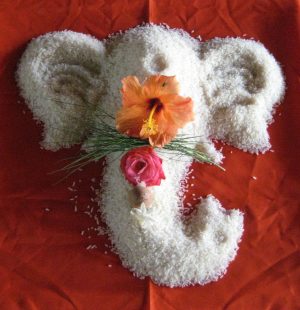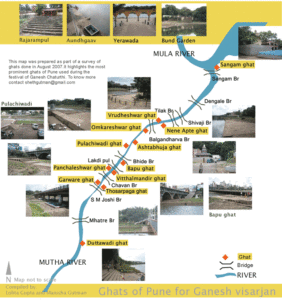Alongside the work we did on the products and materials for the festival, eCoexist also started to look at the issue of waste management for the waste the festival generated. Working along with Swach, eCoexist initiated a campaign to collect and segregate 'nirmalya' the religious waste the people brought to the banks of the river. Here we worked alongside the rag picker women, to convince people to avoid putting the waste into the river and hand it over for segregation and recycling. From among the waste collected several tonnes of flowers were then taken by us to the Yerawada Central Prison where we attempted to make natural colours from these flowers, creating a fantastic experience for the prisoners in turn.
After five years of leading this initiative, eCoexist found a corporate sponsor for the rag pickers and handed over the project to them.
ORIGINS
RELIGIOUS BELIEF
CONTENTS

RELIGION
Ganesh Chaturthi (IAST: Gaṇēśa Chaturthī), is the Hindu festival that reveres god Ganesha. A ten-day festival, it starts on the fourth day of Hindu luni-solar calendar month Bhadrapada, which typically falls in the Gregorian months of August or September. The festival is marked with the installation of Ganesha clay idols privately in homes, or publicly on elaborate pandals (temporary stages). The festival ends on the tenth day after start, wherein the idol is carried in a public procession with music and group chanting, then immersed in nearby water body such as a river or ocean, thereafter the clay idol dissolves. ( Source: Wikipedia)
RESEARCH
WHY IMMERSE?
The issues around toxicity in the festival of Ganesh Chaturthi can be broadly put under three categories
- The impact of immersion of Plaster of Paris on water
- The toxic chemicals contained by chemical paints and the impact of these on water.
- The impact of all the 'nirmalya' - the worship materials when thrown into water.
It should be clearly stated that it is not the materials themselves that are an issue but the fact that they are 'immersed' in natural water bodies that creates an environmental problem.
Study by Toxics Link on impact of immersion
Research paper by Prof Asolekar IIT Mumbai on impacts of immersion
LEGISLATION
Guidelines for immersion by Maharashtra Pollution Control Board
Guidelines for immersion by Central Pollution Control Board
ALTERNATIVES
The ecosensitive alternatives available for this festival include a range of natural or biodegradable materials on the one hand, and reinterpretation of the ritual itself on the other.
Materials that do not cause damage to making ecosystems include:
- Natural Unbaked Clay
- Papier Mache
- Cowdung
Materials that can be used to make decorations and accessories include
- Paper
- Sholapith
- Natural fabrics such as cotton and silk
- Rice husk
- Plants and flowers
EDUCATION
ACTION
NATURAL COLOURS

River cleaning and Nirmala Segregation Campaign
